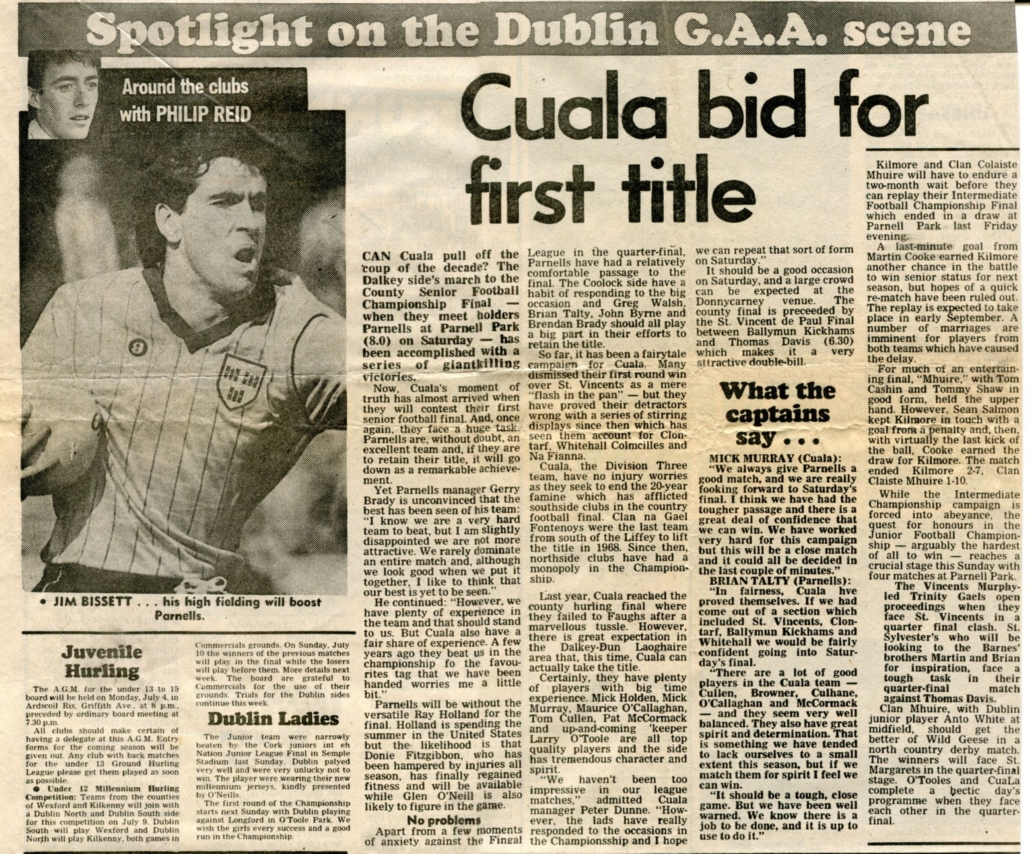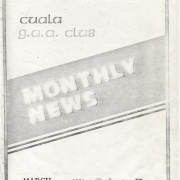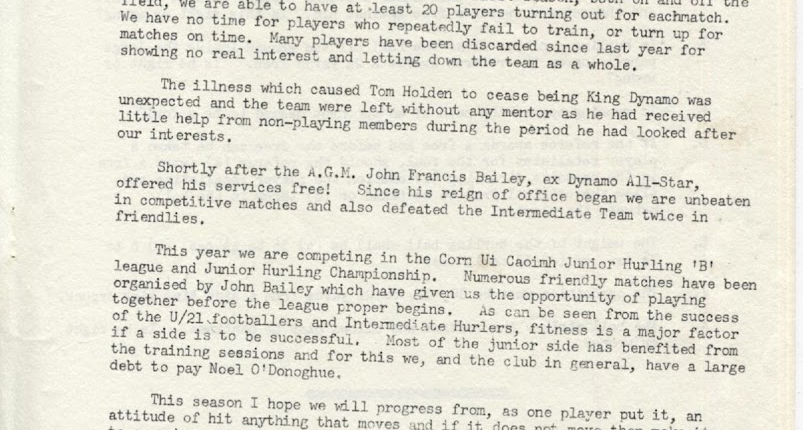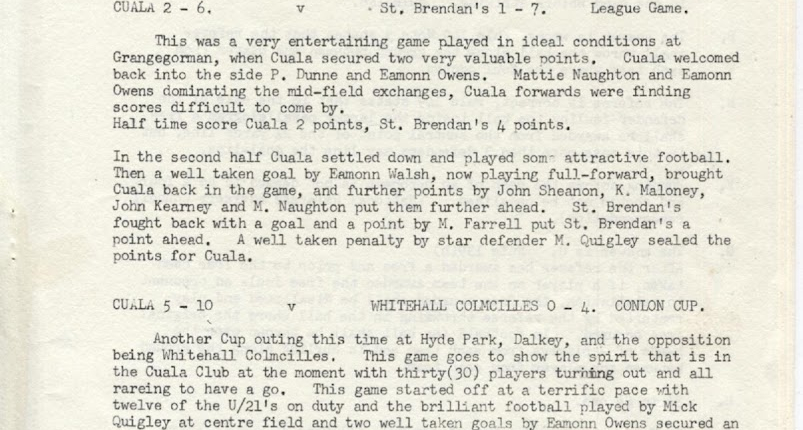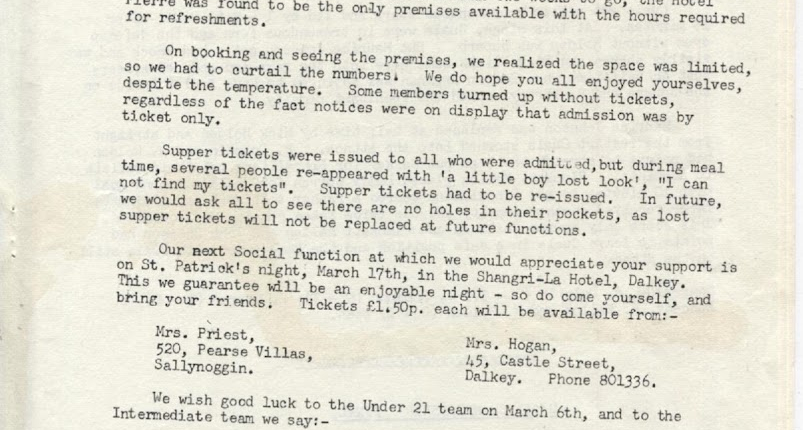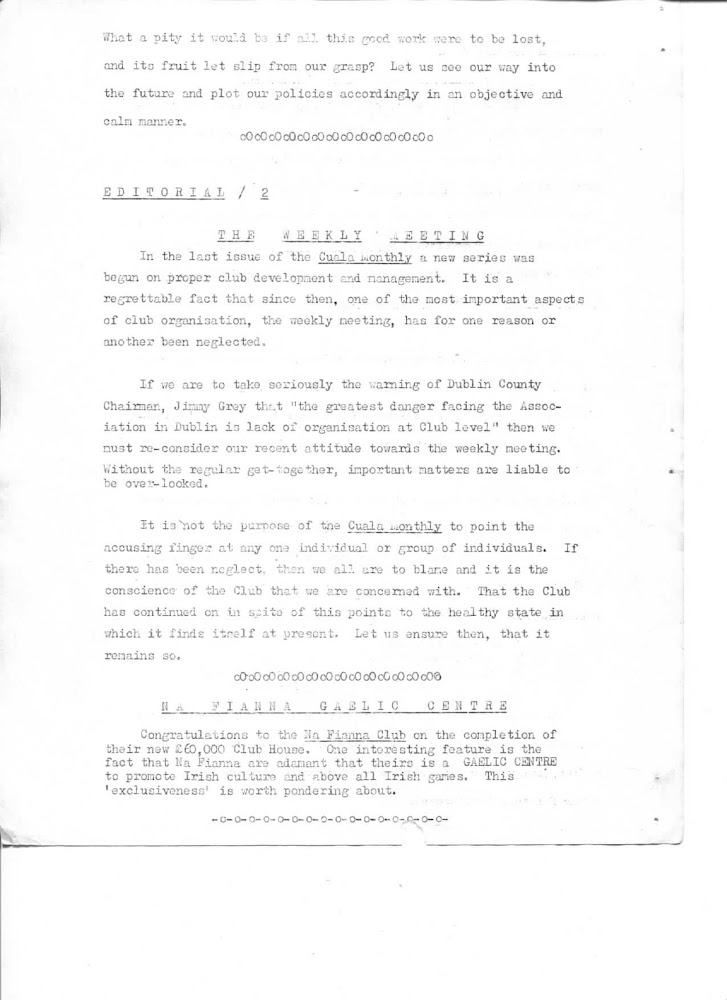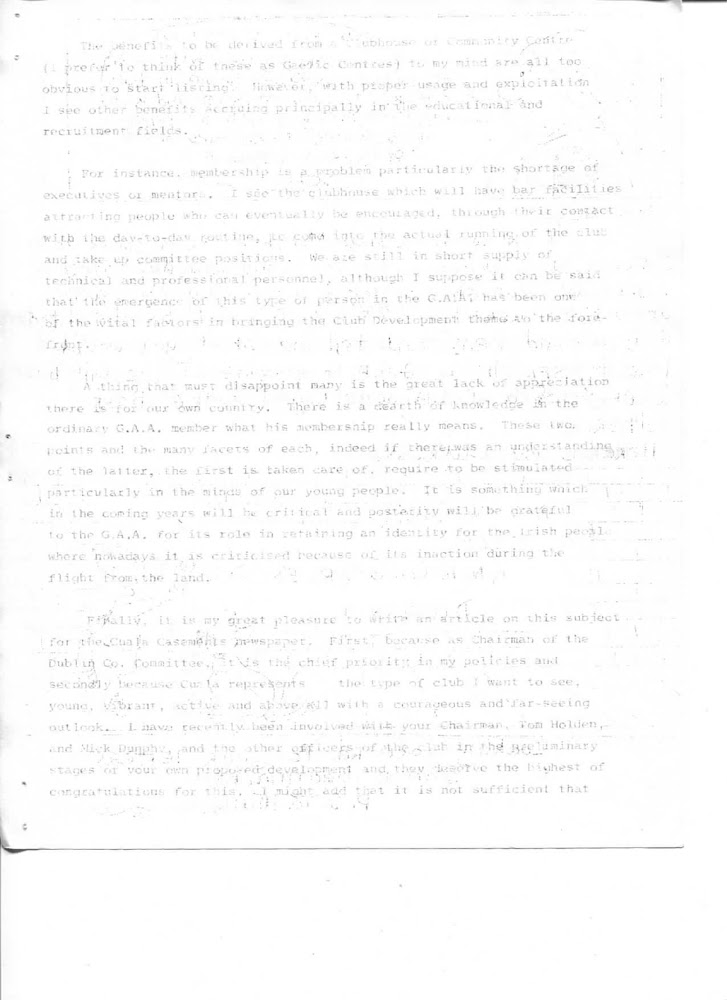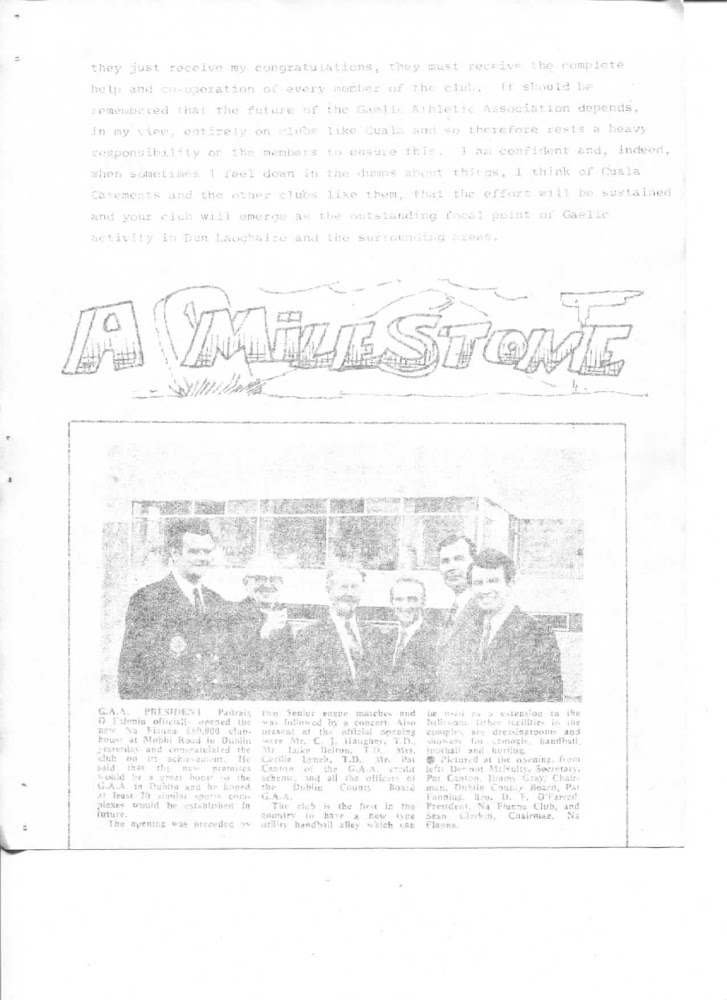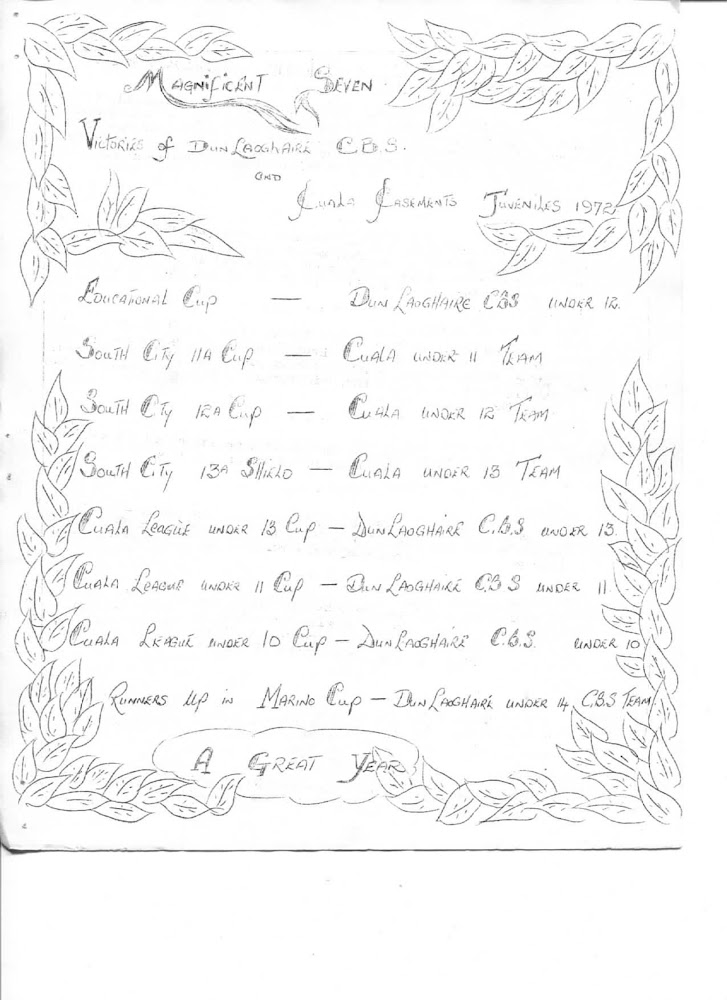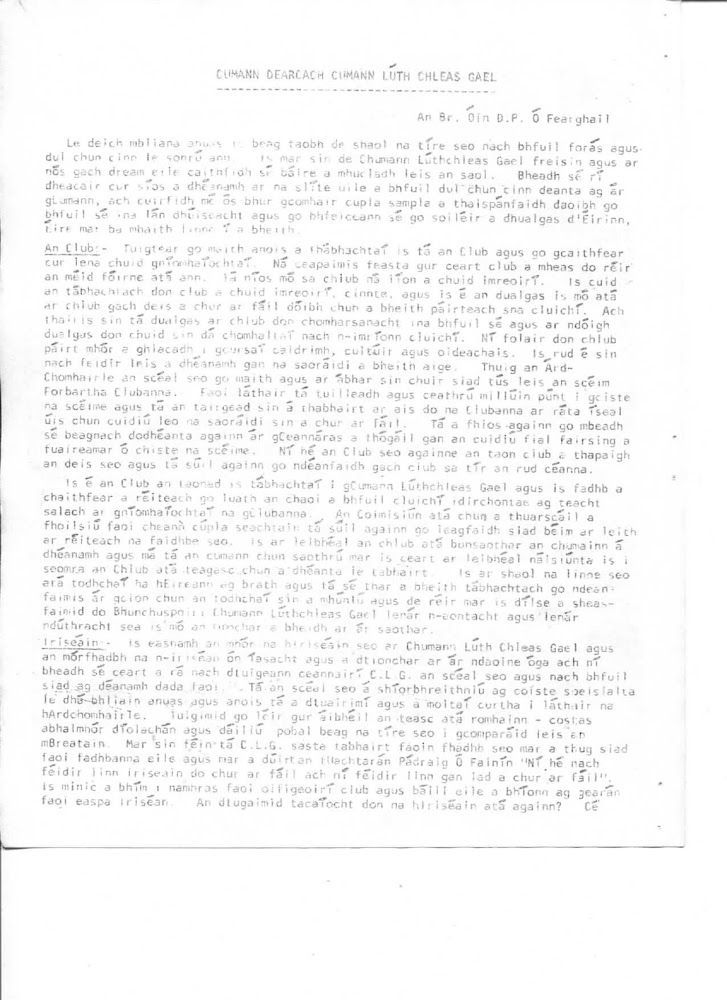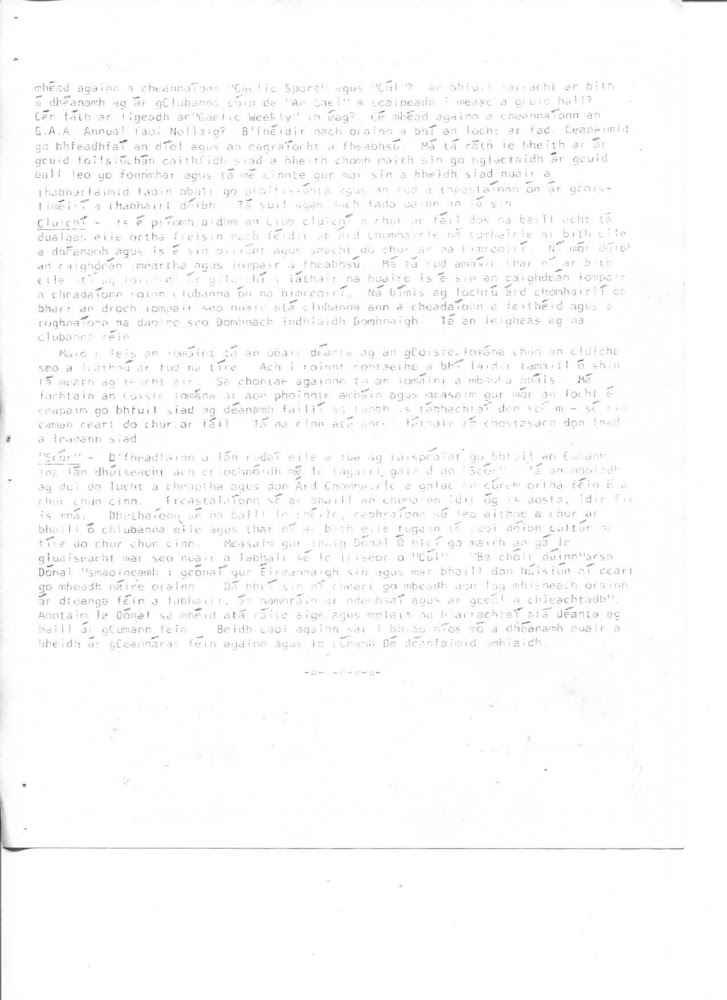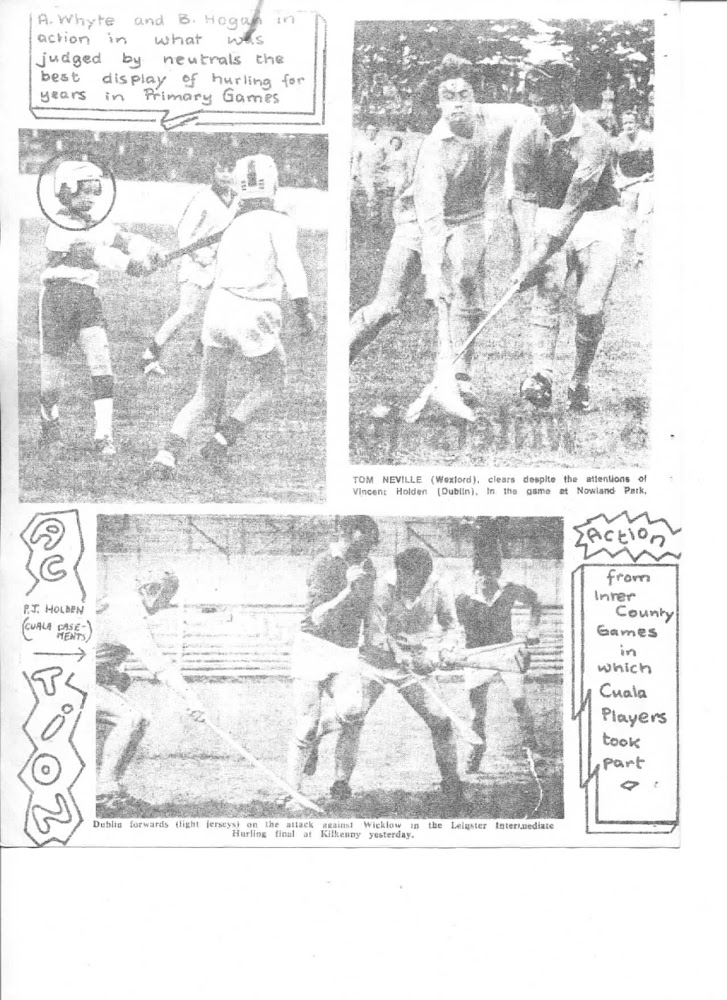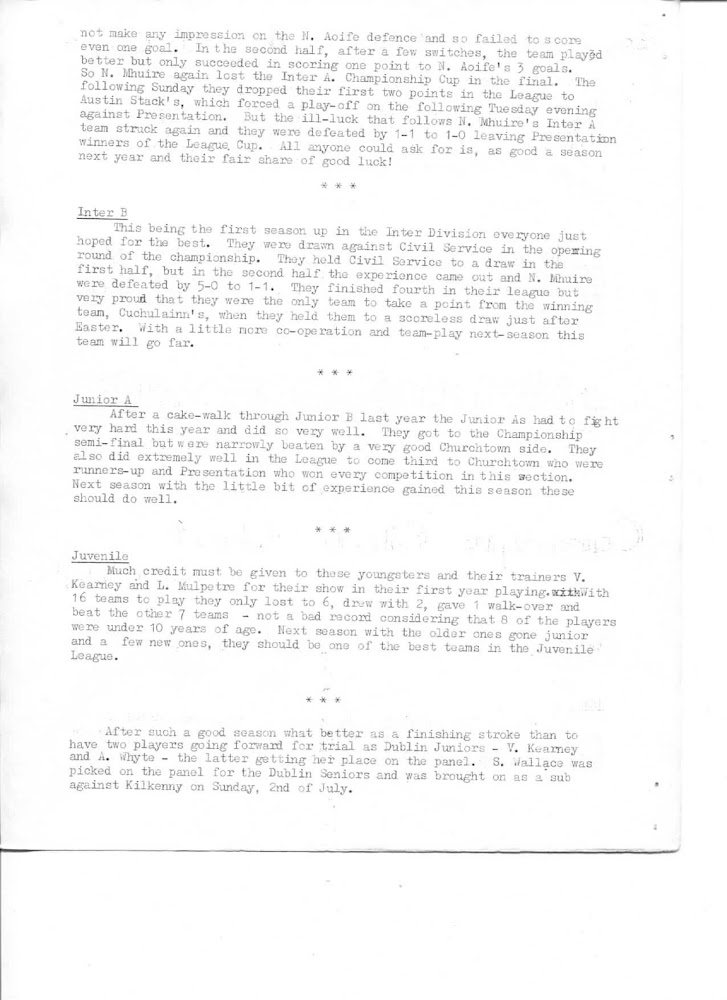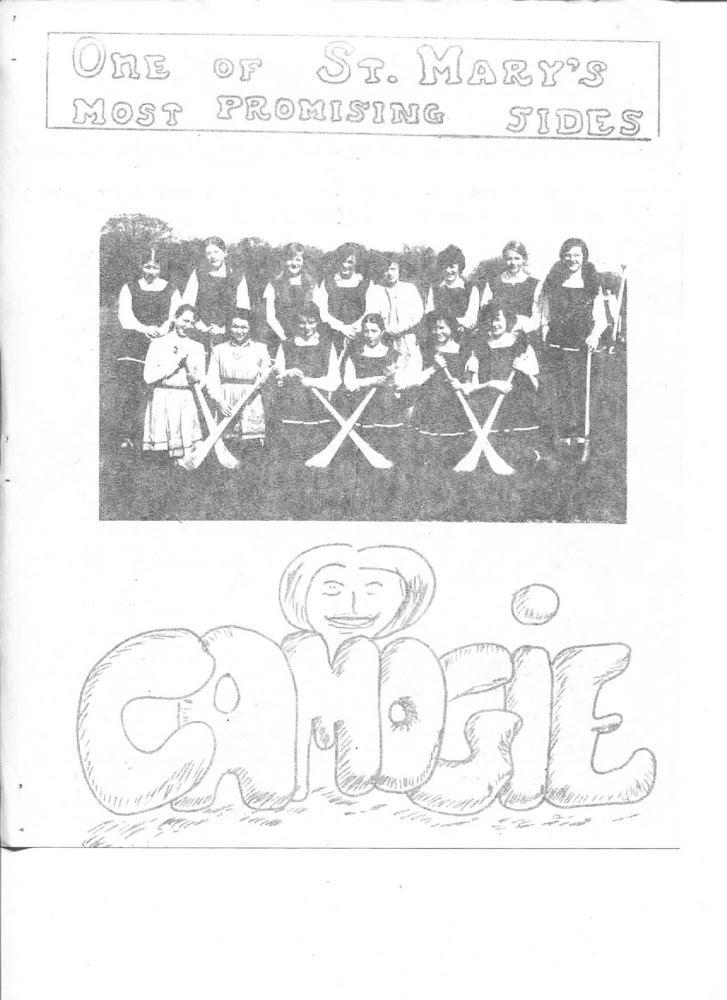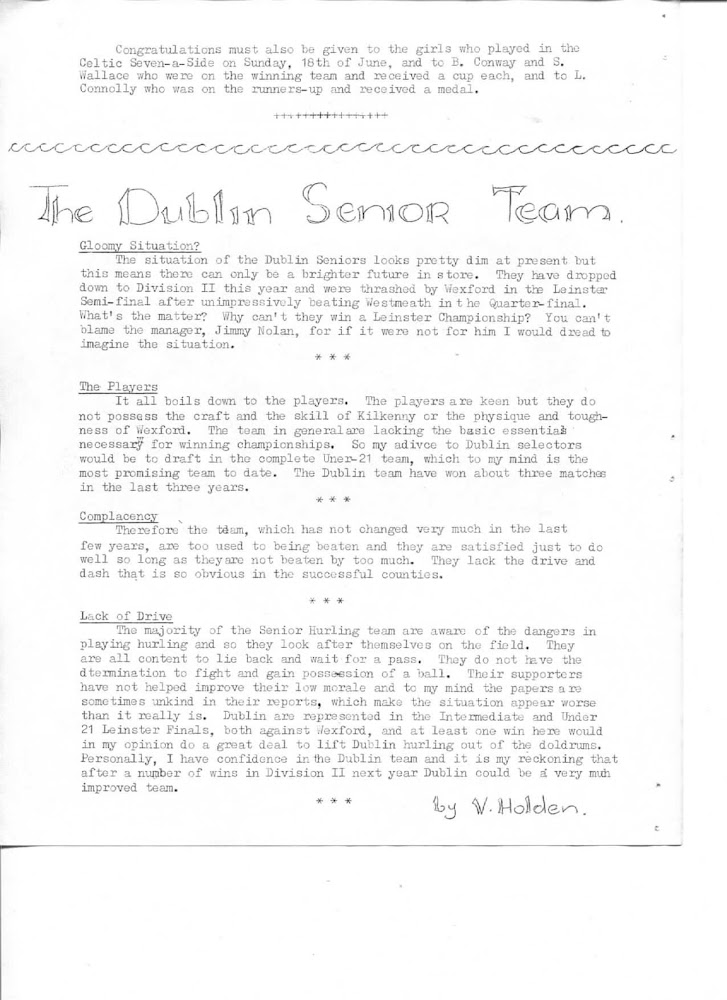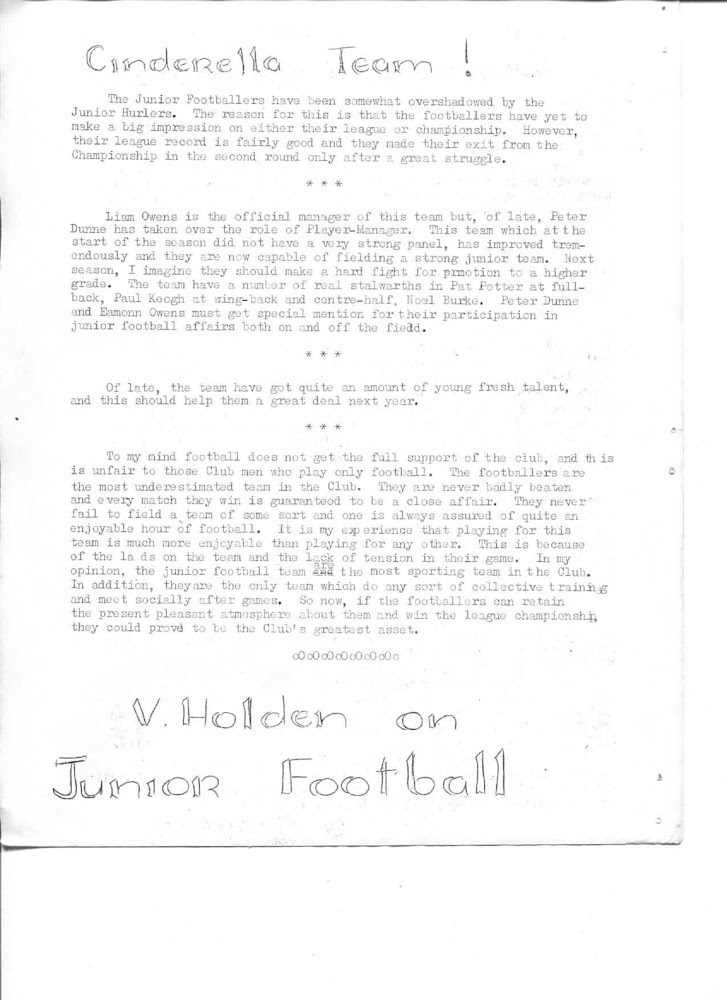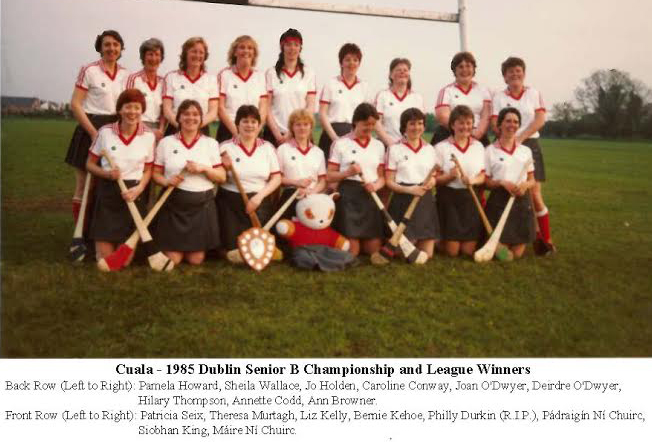
With the Camogie Association celebrating its 120th anniversary in 2024, we took the opportunity to talk to Cuala’s Maire Ui Scolaí (née Ní Chuirc). Máire played camogie for Cuala from the 1970s to the late 1990s as well as working on a voluntary basis for both Dublin Camogie Board and at national level for the Camogie Association, and is hence a source of many insights into the sport at Cuala and beyond. We wanted to find out more about her experiences of Cuala Camogie, those who were involved when she played, some of the successes over the years and her perspectives on how camogie at Cuala and in Dublin is doing now.
Early beginnings
Camogie has existed in this area of Dublin since the 1930s. The Naomh Mhuire (St. Mary’s) camogie club was established in Sallynoggin in 1952 by Matt Kane and his wife Vera, using a pitch that now forms part of Joey’s Soccer Club. In 1979, having sustained an informal collaborative relationship with Cuala over many years, Naomh Mhuire joined with Cuala in Dalkey to form ‘Cuala Hurling, Football and Camogie Club’. Máire noting the pride in seeing all of the codes on Cuala’s headed notepaper, something that wasn’t widespread in Dublin at that time.

Máire’s early camogie years
While attending Coláiste Íosagáin, where Máire first played camogie winning a Dublin Colleges Intermediate League medal in 1973 (her most cherished medal), a Cuala connection was begun. The very first camogie sticks were purchased for the fledgling school through Cuala legend Mick Dunphy! She joined Naomh Mhuire in 1975 before it amalgamated with Cuala, not long really after the marriage bar (which required women to resign from civil service jobs when they got married) was lifted in 1971 and the LGFA was formed in 1974…female participation in sport was not widespread and received little recognition.
Successes of the 70s and 80s
Máire remembers how in the 70s the numbers playing camogie were very small. A campaign was started in the schools in the area to encourage participation, with some of those who joined at that time still well-known and involved in Cuala.
There were, however, many achievements for Cuala around this time. In 1984, the loss of the Senior B championship final led to the enlisting of Cuala’s John Bailey, a former Chairman of Dublin GAA board, to train the team. Máire recounts travelling with Cuala’s Hilary Thompson from Galway (where they both worked at the time) to matches back in Dublin. The determination of the team paid off, with Cuala winning the Senior B league and Championship double in 1985 (read more here). Having won the double in 1985, Cuala went up to Senior A and remained so until 1987.
Meanwhile, Dublin camogie was reaching the heights of the game, with many rural players coming to the city for work and study, and second level colleges doing well throughout the county. We are proud to have had many Cuala players involved in Dublin at the time. Sheila Wallace won an All-Ireland Junior medal in 1971 and captained Dublin to the 1976 All-Ireland Final. Pamela Howard won a junior All-Ireland medal in 1975, with Jo Holden and Bernie Kehoe among others from Cuala who proudly played for county. Dublin won the Senior All-Ireland Championship in 1984 with Sheila Wallace in the backroom team. Sheila also achieved a remarkable place in the camogie story by being appointed as long-standing General Secretary of the (all Ireland) Camogie Association (read more here)
Máire’s roles in camogie administration
Máíre retired from playing with Cuala in 1998, but her involvement with camogie did not diminish. She spent several years as secretary and then PRO of Dublin Camogie, before becoming national PRO for 12 years until 2012, a highlight of her career during which she says she has made lifelong camogie friends to add to those made on the pitch. She is passionate about promoting the sport and points out how despite the inequality in coverage of camogie vs hurling that can still exist, we have come a long way in comparison to the couple of inches that might be written about camogie in the papers in the 1970s. We still have a bit to go so Máire’s advice is for us all to get out and support our women’s camogie teams whenever we can!
How Máire sees Cuala camogie today
2024 has been a huge year for celebrating 120 years of camogie, alongside 50 years of the LGFA and 140 years of the GAA. Camogie at Cuala has flourished thanks to the work of so many over the years and the structures that were put in place from the beginning to put camogie on an equal footing to the other codes. In 2024 Cuala won the Minor Division 1 and Junior 2 Leagues, reached the Minor Division 1 Championship Final, won the U21 Championship Shield and the Senior Division 2 Championship title.
Dublin camogie is also experiencing a resurgence, winning the National League Division 1B title for the first time since 1983 as well as the Division 3B league, where Cuala’s Sinéad Murphy won player of the match, playing alongside Hilary Thompson’s daughter Róisín Ní Drisceoil. Dublin also reached the All-Ireland Senior Camogie semi-final for the first time in 7 years with Sinéad Wylde, Hannah O’Dea and Sinead Murphy on the panel.
Let’s hope for even greater success for Cuala and Dublin camogie in 2025.
A final word..
We asked Máire what she would say to our young girls starting out learning to play camogie at Cuala, taking part in GoGames and moving on to competitive matches. Her ultimate advice is to enjoy playing and spending time with the friends you make. Playing field sport is so important as you have to take the good and the bad. But the team spirit lifts you up through the harder times so you can celebrate the achievements. Keep having fun!
Ní fhéadfainn mo shaol a shamhlú gan Camogie agus Cuala!
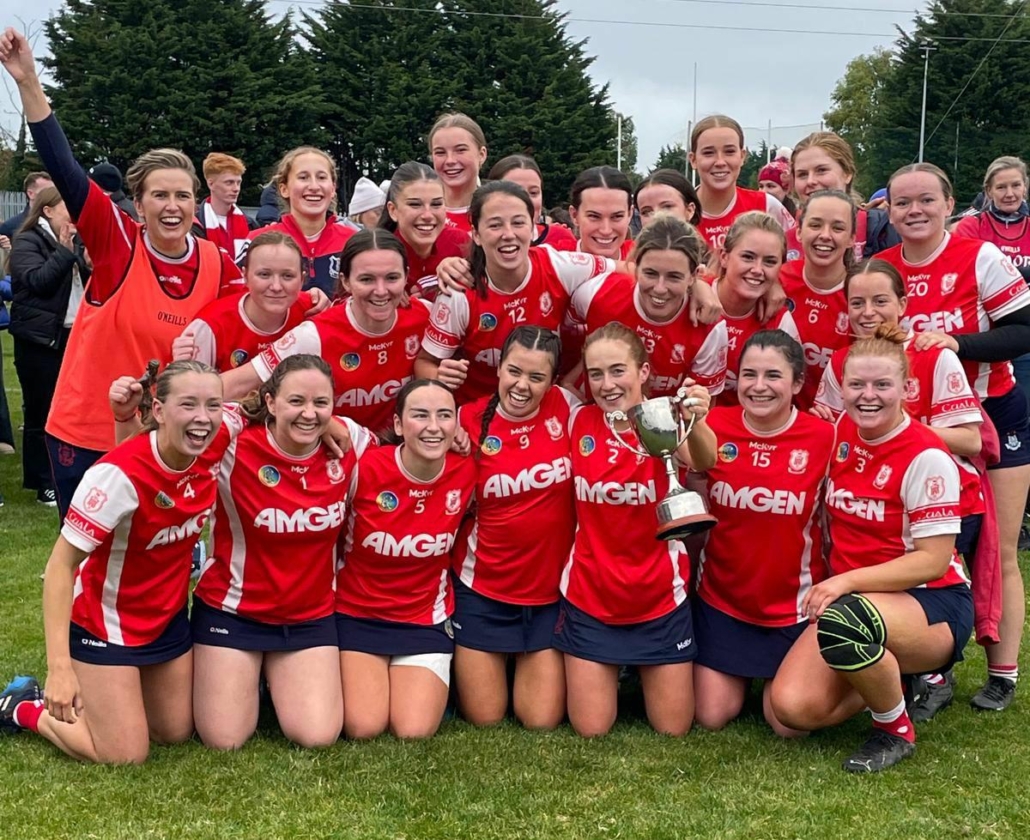
 Cartlann Digiteach Cuala (Cuala Digital Archive) maintains an on-line archive of images and stories relating to Cuala, its ‘ancestral’ clubs and other Gaelic clubs that once operated in its area. If you have any information or material to share with us, please contact –
Cartlann Digiteach Cuala (Cuala Digital Archive) maintains an on-line archive of images and stories relating to Cuala, its ‘ancestral’ clubs and other Gaelic clubs that once operated in its area. If you have any information or material to share with us, please contact –
Michael Goodwin, +353 (0) 87 2266140, history@cualagaa.ie
 Noel O’Donoghue was the man with the whistle in 1980 (Joe Connolly’s Galway beat Sean Foley’s Limerick (2:15 to 3:09) and again in 1982 (Brian Cody’s Kilkenny saw-off Jimmy Barry Murphy’s Cork 3:18 to 1:13). Noel was supported by 4 Cuala clubmates as umpires in these fixtures – Proinsias O’Maoláin (1980 & 1982), Frank McHugh (1980 & 1982), Sean Moran (1982) & John Bailey (1980). He was remembered in 2022 as being among Five of the Best Referees by the Irish Independent and went on to serve in many positions overseeing Match officials and Hawkeye
Noel O’Donoghue was the man with the whistle in 1980 (Joe Connolly’s Galway beat Sean Foley’s Limerick (2:15 to 3:09) and again in 1982 (Brian Cody’s Kilkenny saw-off Jimmy Barry Murphy’s Cork 3:18 to 1:13). Noel was supported by 4 Cuala clubmates as umpires in these fixtures – Proinsias O’Maoláin (1980 & 1982), Frank McHugh (1980 & 1982), Sean Moran (1982) & John Bailey (1980). He was remembered in 2022 as being among Five of the Best Referees by the Irish Independent and went on to serve in many positions overseeing Match officials and Hawkeye John Bailey refereed the 1986 Hurling Final (Tom Cashman’s Cork overcame Noel Lane’s Galway (4:13 to 2:15) and had a team of 4 Cuala umpires – Jimmy Doyle, Austin Duffy, Frank McHugh and Dominic Byrne. John brought the Cuala crest to even higher office when he twice served as Dublin County Chairman, 1993 – 1998 and 2001 – 2006. During his first tenure he was centrally involved in the re-development of Parnell Park.
John Bailey refereed the 1986 Hurling Final (Tom Cashman’s Cork overcame Noel Lane’s Galway (4:13 to 2:15) and had a team of 4 Cuala umpires – Jimmy Doyle, Austin Duffy, Frank McHugh and Dominic Byrne. John brought the Cuala crest to even higher office when he twice served as Dublin County Chairman, 1993 – 1998 and 2001 – 2006. During his first tenure he was centrally involved in the re-development of Parnell Park.


 Cartlann Digiteach Cuala (Cuala Digital Archive) maintains an on-line archive of images and stories relating to Cuala, its ‘ancestral’ clubs and other Gaelic clubs that once operated in its area. If you have any information or material to share with us, please contact –
Cartlann Digiteach Cuala (Cuala Digital Archive) maintains an on-line archive of images and stories relating to Cuala, its ‘ancestral’ clubs and other Gaelic clubs that once operated in its area. If you have any information or material to share with us, please contact –






 Cartlann Digiteach Cuala is grateful to Fintan Quill for highlighting the 10th Anniversary of the passing of a Cuala “giant” Eugene Egan
Cartlann Digiteach Cuala is grateful to Fintan Quill for highlighting the 10th Anniversary of the passing of a Cuala “giant” Eugene Egan


